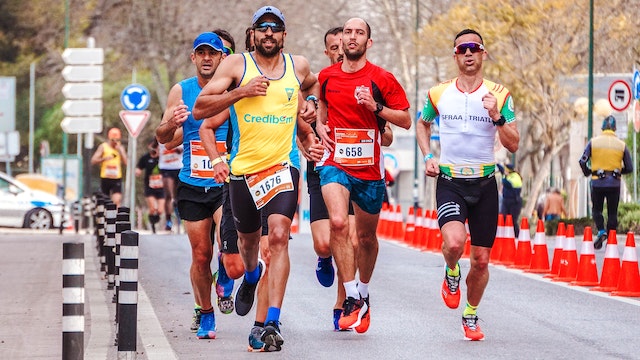
What causes the “wall” when running? It is caused by your liver and muscles running out of glycogen.
All of the chemical processes in our bodies only work if we can supply them with energy. We get that energy from the food we eat. Whenever we eat anything, it is broken down in our intestines into its component parts by enzymes and absorbed. We take the minerals, the proteins, the vitamins, and we break the carbohydrates down into glucose. This is a simple sugar that our body uses as its main source of energy. The glucose passes into our blood from the intestines and cells start to use it for their chemical processes. The glucose is oxidized to produce water, carbon dioxide, and the energy released is used by the cell. We need this energy to produce cells, grow hair, and move.
Our bodies can’t use all of the energy that we get from the food we eat, and we have evolved several ways to store it for times when we can’t get enough food. The first storage mechanism is by making the glucose into glycogen. The body connects many units of glucose around a glycogenin protein to make glycogen. There could be more than 30,000 glucose units in each unit of glycogen. The body then stores these glycogen units in the liver and in the skeletal muscles ready to be used when the body needs a source of energy.
The second storage mechanism is our body fat. Fat is a far more efficient way to store energy than simply having glucose stored as glycogen. 1 kg of fat holds about 9,000 calories and 1 kg of glycogen holds about 1,500 calories. Fat can hold more energy than glycogen, but your body cannot burn fat for energy as easily as it can glycogen. It takes time to transport the fat cells to where they are needed, and they require a lot more oxygen to break down than glycogen does. Depending on the size of the individual and how much and how recently they have eaten, there could be between 400 and 600 g of glycogen stored in the body, which works out to almost 1,000 calories.
So, what causes the “wall”? If you start to run, your body needs to burn more energy to keep your muscles contracting at speed. If you run a short distance and stop, your body will have burned through some of its glycogen stores, but you will still have a lot left. They will be replenished when you eat, or by slowly burning fat. However, if you keep running, the body faces another problem.
When you start to run, you have glucose in your blood that the muscles can use. Once that is gone, the muscles can use the glycogen stored in them and the glycogen stored in the liver. All of this together adds up to about 1,800 calories. The average person burns about 60 calories per kilometer, so 1,800 calories will get the average person approximately 30 kms. Not coincidentally, most people experience the wall at about the 30 km mark of a marathon.
When you have depleted all of your glycogen stores, it becomes very difficult to keep contracting your muscles. People have difficulty walking, let alone running. There is a bigger problem than the muscles though. One of the largest consumers of glycogen in our body is our brain. Our brain requires approximately 20% of the body’s energy to keep functioning. Once all of the glycogen is gone, the brain starts to have trouble. People who hit the wall can feel dizzy, light-headed, confused, and nauseous as the brain has trouble functioning. They can also feel anxious and hopeless. Pushing through the wall is extremely difficult because the brain goes into survival mode and tries to make you stop.
Is there a way to beat the wall? You can try to become an elite athlete. Eliud Kipchoge burned about 2,300 calories when he ran his 2 hour 1 minute marathon, which means he has finished long before he hits the wall. You can also try carb loading. The idea there is to have more glycogen in your body before you start. With training, you can get your body to hold quite a lot more glycogen than usual. And, of course, you can eat and use sports drinks while you are exercising. If you can replenish your stores while you are running, you can hold off the wall. And this is what I learned today.
Photo by RUN 4 FFWPU: https://www.pexels.com/photo/people-running-2002209/
Sources
https://learn.genetics.utah.edu/content/metabolism/bbs
https://www.ncbi.nlm.nih.gov/books/NBK26882/
https://kidshealth.org/en/teens/glycogen.html
https://en.wikipedia.org/wiki/Glycogen
https://learn.genetics.utah.edu/content/metabolism/bbs
https://my.clevelandclinic.org/health/articles/23509-glycogen
https://www.mikevarneyphysio.co.uk/psychology-hitting-the-wall
https://www.verywellfit.com/what-is-glycogen-2242008
https://www.verywellfit.com/the-bonk-during-exercise-3119976
https://en.wikipedia.org/wiki/Hitting_the_wall
